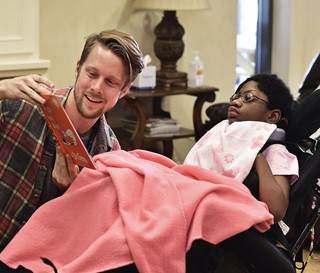Medical students volunteering at HOV learn compassionate presence

Chris Bean reads to patient Fatima Faye.
Photo by Delbert Vega
By Beverly Medlyn
Communications Director
Medical students devote most of their learning to the science of medicine—diagnosis, testing, disease progression, treatments, technology and medications.
But this summer, students at the University of Arizona College of Medicine—Phoenix are volunteering at Hospice of the Valley, where the focus is less on cure and more on comfort. The first group of 25 began early this summer and a second is going through training this month.
The students are volunteering at two palliative care inpatient homes—Ryan House for children and Gardiner Home for adults. Ryan House is operated in partnership with Hospice of the Valley to provide respite and end-of-life care for children and support for families. Gardiner Home is Hospice of the Valley’s inpatient and respite home dedicated solely to dementia patients.
“My prior experience in medicine has focused on the curative aspect—how to cure whatever is going on with the patient,” said Cayman Martin, 25, a second-year medical student. “What’s different about being at Ryan House and Gardiner Home is it’s more about making the patient feel comfortable, not fixing the problem. Enjoying the time they have.”
Chris Bean, a second-year student, worked with Hospice of the Valley’s volunteer department to offer the program in conjunction with the medical school’s service-learning program called CHIP (Community Health Initiative—Phoenix). Bean, 24, has volunteered five years for HOV as an 11th Hour Companion, sitting at the bedside of patients very close to death who don’t have family or have a family member requesting support.
Happier circumstances are more typical at Ryan House and Gardiner Home—both places where people go for limited time periods for respite care so family caregivers can take breaks or for end-of-life care. “Ryan House is like Disneyland,” Bean said. “It’s fun to see how much joy the kids bring to others. Playing and spending time with them—it’s hard not to feel that and have your mood lightened.”
On a recent summer afternoon, Bean played guitar, piano and chimes for Sadie, 7, and read “Green Eggs and Ham” to Fatima, 10. Both girls were wheelchair bound and didn’t speak, but communicated with their eyes and smiles. “I don’t even know what conditions they have,” he said. “I’m here just to find out what they like to do and play.” “Sometimes end of life can be a topic that gets glossed over in medical school,” Bean said. “A lot of times death is seen as a loss or failure for physicians. But in reality, if you ask people if they want to pass away in an intensive care unit hooked up to machines or at home with their pain managed, they don’t want to be in a hospital. I think it’s great that medical students have an opportunity to see hospice.”
Martin’s prior experience in emergency medicine gave her some exposure to sudden death. “Gardiner Home patients also are actively dying, but in a very different way,” she said. “I’m grateful to interact with different kinds of patients in different settings. It’s been a rewarding experience and definitely eye opening.”
